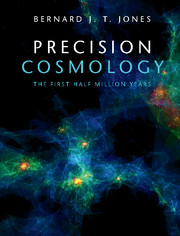Book contents
- Frontmatter
- Dedication
- Contents
- Preface
- Notation and Conventions
- Part I 100 Years of Cosmology
- Part II Newtonian Cosmology
- Part III Relativistic Cosmology
- Part IV The Physics of Matter and Radiation
- 19 Physics of the CMB Radiation
- 20 Recombination of the Primeval Plasma
- 21 CMB Polarisation
- 22 CMB Anisotropy
- Part V Precision Tools for Precision Cosmology
- Appendix A SI, CGS and Planck Units
- Appendix B Magnitudes and Distances
- Appendix C Representing Vectors and Tensors
- Appendix D The Electromagnetic Field
- Appendix E Statistical Distributions
- Appendix F Functions on a Sphere
- Appendix G Acknowledgements
- References
- Index
21 - CMB Polarisation
from Part IV - The Physics of Matter and Radiation
Published online by Cambridge University Press: 04 May 2017
- Frontmatter
- Dedication
- Contents
- Preface
- Notation and Conventions
- Part I 100 Years of Cosmology
- Part II Newtonian Cosmology
- Part III Relativistic Cosmology
- Part IV The Physics of Matter and Radiation
- 19 Physics of the CMB Radiation
- 20 Recombination of the Primeval Plasma
- 21 CMB Polarisation
- 22 CMB Anisotropy
- Part V Precision Tools for Precision Cosmology
- Appendix A SI, CGS and Planck Units
- Appendix B Magnitudes and Distances
- Appendix C Representing Vectors and Tensors
- Appendix D The Electromagnetic Field
- Appendix E Statistical Distributions
- Appendix F Functions on a Sphere
- Appendix G Acknowledgements
- References
- Index
Summary
The polarisation of the CMB provides one of the most important tools we have for exploring the Universe. We will see that there are two distinct modes of polarisation, the E-mode and the B-mode, from which we can produce E-mode and B-mode maps. The modes are sensitive to different physical phenomena and so we can separate out different effects such as the gravitational lensing of the CMB and the contributions from late re-ionisation of the cosmic plasma. These would otherwise be inextricably mixed in with the usual temperature maps. The cosmological B-mode is only generated by primordial gravitational waves, so their discovery would be one of the most important advances in understanding the very earliest stages of the cosmic expansion.
A Bit of History
In 1968, Rees (1968) pointed out that in an anisotropic model Universe, the microwave background radiation emerging from the recombination period would be polarised. The observed polarisation would reflect the last few scatterings of the photons just prior to the recombination. The first attempt to detect polarisation was reported by Nanos (1979)onthe basis of his thesis work in 1973–1974 under the supervision of David Wilkinson. Perhaps not surprisingly, he could only put upper limits on any anisotropy, but it was an important first step. Subsequently, Caderni et al. (1978); Lubin and Smoot (1981) attempted to improve on the limits set by Nanos. However, it was not until 2002 when Kovac et al. (2002) reported the first positive detection of polarisation by the DASI ground-based experiment team. Shortly afterwards a positive detection was reported from the WMAP experiment (Kogut et al., 2003; Page, 2003).
The 2003 flight of the BOOMERANG long-duration balloon-borne experiment, launched from the South Pole, was one of the great CMB mapping experiments. The 1998 flight had already revealed, for the first time, the first two peaks of the temperature power spectrum (de Bernardis, 2000; Ruhl, 2003), while the 2003 flight yielded the first polarisation power spectrum. The data and analysis papers of the 2003 flight did not appear until 2006 (Jones, 2006; MacTavish, 2006).
The Background Physics
Here we present the physics of how electromagnetic waves in a vacuum scatter off electrons. The main process of interest in the cosmological context is Thomson scattering, the scattering of light off a free electron.
Information
- Type
- Chapter
- Information
- Precision CosmologyThe First Half Million Years, pp. 491 - 515Publisher: Cambridge University PressPrint publication year: 2017
